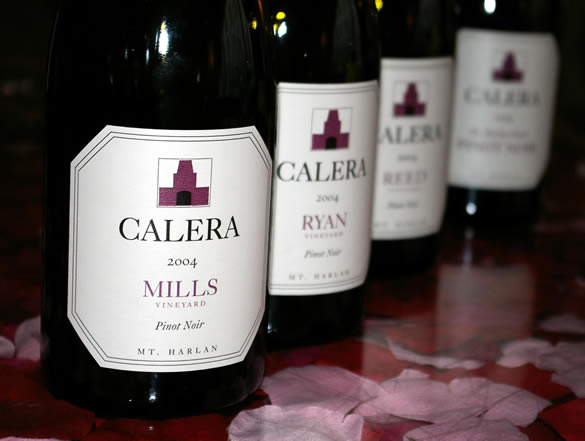|
Josh
Jensen and the wines
of
Calera

Josh Jensen’s story is an interesting one. Like many
others, he fell in love with wine, fell in love with Burgundy, and
wanted to do something similar in his home country. And, to a
large degree, he has succeeded. He’s making some really
fantastic Pinot Noir, but perhaps because he’s been doing this
for a while, he doesn’t seem to get the press he deserves. I met
him in trendy Regent Street restaurant Cocoon
to taste his wines and talk about where they have come from.

Jensen (above) is a California native who headed
East for University (Yale), and then crossed the Atlantic to do
graduate school at Oxford in 1966. He rowed in the boat race that
year, and recently attended the 40th reunion of the ’66 crew in
the boat house in Wallingford.
During his spell in the UK Jensen ‘became enamoured
of fine wines’, to use his own words, and in particular classic
French wines. So, after he left Oxford, he travelled round the
wine regions of France, knocking on the door of DRC in 1970 and
Domaine Dujac in 1971 to do harvests. ‘I was the luckiest picker
ever at DRC’, recalls Jensen. ‘André the cellarmaster needed
me in the cellar because he had English-speaking visitors, so I
got to taste all the wines. They were lovely. I learned so much
from tasting those wines and hearing André talk about them.’
This was the start of a mission that was to end with
Calera. Jensen headed back to California and started looking for
limestone, which he considered to be the key to producing great
Pinot Noir. He soon realized there is very little limestone in
California, which made the quest especially demanding. Jensen
spent two years traipsing round the state looking at remote
ranches, and finally found one: a ranch built on a 3 million ton
limestone deposit south of San Francisco was for sale.
It was in San Benito County, high up in a small
mountain chain known as the Gavilian Mountains, 25 miles east of
Monterey Bay. This property had no electricity or telephone
service, nor a paved road – access was by a steep four-mile dirt
road. He planted the first three vineyard parcels in 1975, named
Selleck, Jensen and Reed, after three older people who helped him
get started. In 1983 he planted his first Viognier, then in 1984
he planted the first Chardonnay vineyard and a fourth Pinot
vineyard, named Mills.
We try the Viognier to start with. Jensen laments that
Viognier is now out of fashion in California, as are Chardonnay
and Sauvignon Blanc. ‘Drinking Chardonnay and Sauvignon is
considered like kissing your sister’, he claims. Sommeliers are
touting Greek whites and reds as the next exciting new frontier,
as well as Argentinean wines. But he’s not daunted by this.
‘We’re in a long-term business: things come into fashion and
go out of fashion, so we hunker down and get on with it.’
Calera Mount Harlan Viognier 2004
There’s a slight smoky, minerally edge to the nose, which
otherwise shows honeyed fruit. The palate is quite generous and
rich with a full fruit and some crispness on the finish. It has a
bit of a split personality: one moment it’s fruity and bright,
the next it is rich and alcoholic. 88/100
The first Viognier here was made in 1989, when Josh was
one of the four producers in the state working with the variety.
This variety then had a good long run as an exciting alternative
white, receiving good press and widespread recognition, and being
able to charge high prices. In January 07 Jensen had to do a big
price cut, from US$36
to $28.
But if things are tricky for Viognier, the opposite is
the case for Pinot Noir. ‘Pinot is going crazy’, says Jensen.
‘Pinot is insane in California and across America. We just
can’t keep it in the warehouse’. It’s getting hard to source
Pinot in California, and sales of wines made from this variety
were up 54% in 2005. This was part Sideways
effect (a film that featured Californian Pinot Noir), but
Jensen notes the trend had already started when the film came out
in October 2004.
All Calera’s Pinot Noirs come from Jensen’s own
vineyards. The original vineyards were planted with 6’ × 10’
close spacing, and then two newer vineyards were planted in 97 and
98 at double the density. Low yields is one of the keys to quality
here: the historical average in the older Pinot Noir vineyards is
1.5 tons/acre.
Organics is practiced in the vineyards, but Calera is
not certified. Jensen’s organic advisor reckons that Calera
would sail through the certification, and because they have used
organic methods for long enough there would be no need for a
conversion process. Jensen is stalling on this because of what
could be a big cash outlay.
To be certified you have to pay a percentage of the
cash value of your crop, which Jensen reckons would be around
US$1500 per year, but he was concerned at one point that it would
be closer to $10 000. In the USA, you can’t call your wine
‘organic’ unless you don’t use any sulphur dioxide in the
winemaking process. ‘The US Government requirements are
crazy’, says Jensen. The cut-off point for organic wine is 10
ppm SO2, and the US Government tests every batch of wine. ‘It is
just for wineries who sell their wine to hippies. There would be
huge bottle variation and no serious professional winery would try
to do this’.
Now you can label your wine as ‘from organically
grown grapes’, but for a while you couldn’t do this. So this
is an option, but to do this you have to get your winery inspected
and the building has to be approved. ‘You pay some inspector to
come in and say your hoses, tanks and barrels are OK, and they
look at your cleaning products. Then your building is sanctioned
as a place OK for processing these grapes’, explains Jensen.
‘The trend around the world in grape growing is to
want to do things in a sustainable way with fewer chemical inputs,
using manure, composts and tending to the health and life of the
soil’, Jensen continues. ‘I think this is the way of the
future. Certainly, US consumers will want this more and more.
We’re getting more questions from consumers about whether we are
organic’.
Winemaking is with whole clusters, punched down. No
cold soak is used, because Jensen thinks this isn’t a good way
to go with Pinot. Temperature control is used to stop the tanks
going over 90 degrees F. When the cap falls, the wines are
pressed. Gravity flow is used in the winery, which has seven
different levels. Usually only one pumping is needed, to barrels.
A tiny amount of sulphur dioxide is added when grapes come in just
to kill spoilage yeasts. No more is added until malolactic is
complete.
‘For me, what really defines a great wine is not
power or opulence’, explains Jensen. ‘It is complexity,
nuances and tertiary flavours’. He laments the current obsession
with big, rich wines. ‘Hopefully the pendulum is starting to
swing back to more traditional styles. I see baby steps in that
direction – or it might be wishful thinking!’
Calera Mount Harlan Cuvée Pinot Noir 2004
Barrel selection from the five single vineyards. Lovely sweet
dark cherry nose is poised and balanced. It’s ripe and
attractive. The palate is nicely savoury with good dark cherry and
spice characters. Some tannic structure alongside the elegant
fruit. Quite chewy and rich. 90/100 (£20/$30 retail)
Calera Ryan Vineyard Pinot Noir 2004
Vineyard planted in 1998 and 2001, close spaced. Open, sweet
dark cherry fruit nose is quite elegant and fine. Smooth and pure.
The palate has lovely sweet fruit with a nice spicy edge. It’s
pure and quite elegant with lovely spicy structure. Delicious.
92/100
Calera Mills Vineyard Pinot Noir 2004
Planted in 1984. Lovely aromatic nose showing dark, spicy
fruit. The palate displays rich sweet, rounded fruit and also some
spicy structure. This is fantastic: it’s rich and sweetly
fruited but still brilliantly balanced. Weighs in at a heady 15%
alcohol. 93/100
Calera Reed Vineyard Pinot Noir 2004
Planted in 1975. ‘Year after year, this is the softest and
smoothest of our vineyards’, says Jensen. Distinctive aromatic
sweet herbal nose. There’s a subtle sort of greenness here,
along with real sweetness of fruit. The palate is open and elegant
with lively sweet herb-tinged fruit, finishing with a bit of
spice. A distinctive style of wine. 92/100
Calera Jensen Vineyard Pinot Noir 2004
Planted in 1975. Sweet, pure blackberry, cherry and spice nose
is quite lush and seamless. The palate has lovely broad, sweet
rounded red fruits with a lovely softness. There’s some smooth
tannic structure under the fruit. This is a sweet, pure, elegant,
structured wine of real concentration. 95/100
Calera Selleck Vineyard Pinot Noir 2004
Lovely aromatic nose of sweet cherry fruit with a warm, herby
edge. Pure, smooth and quite elegant. The palate is pure with
elegant red tarry fruit and some lovely bright spicy structure.
Sweet, pure, elegant and compelling. 93/100
UK availability of these wines: Bibendum Wine carry
a small selection.
Wines tasted 07/07
Find these wines with wine-searcher.com
Back
to top
|

